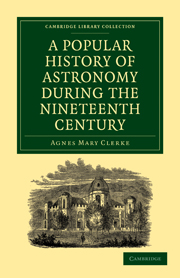Book contents
- Frontmatter
- PREFACE
- Contents
- INTRODUCTION
- Part I PROGRESS OF ASTRONOMY DURING THE FIRST HALF OF THE NINETEENTH CENTURY
- CHAPTER I FOUNDATION OF SIDEREAL ASTRONOMY
- CHAPTER II PROGRESS OF SIDEREAL ASTRONOMY
- CHAPTER III PROGRESS OF KNOWLEDGE REGARDING THE SUN
- CHAPTER IV PLANETARY DISCOVERIES
- CHAPTER V COMETS
- CHAPTER VI INSTRUMENTAL ADVANCES
- Part II RECENT PROGRESS OF ASTRONOMY
- INDEX
CHAPTER III - PROGRESS OF KNOWLEDGE REGARDING THE SUN
Published online by Cambridge University Press: 07 September 2011
- Frontmatter
- PREFACE
- Contents
- INTRODUCTION
- Part I PROGRESS OF ASTRONOMY DURING THE FIRST HALF OF THE NINETEENTH CENTURY
- CHAPTER I FOUNDATION OF SIDEREAL ASTRONOMY
- CHAPTER II PROGRESS OF SIDEREAL ASTRONOMY
- CHAPTER III PROGRESS OF KNOWLEDGE REGARDING THE SUN
- CHAPTER IV PLANETARY DISCOVERIES
- CHAPTER V COMETS
- CHAPTER VI INSTRUMENTAL ADVANCES
- Part II RECENT PROGRESS OF ASTRONOMY
- INDEX
Summary
The discovery of sun-spots in 1610 by Fabricius and Galileo first opened a way for inquiry into the solar constitution; but it was long before that way was followed with system or profit. The seeming irregularity of the phenomena discouraged continuous attention; casual observations were made the basis of arbitrary conjectures, and real knowledge received little or no increase. In 1620 we find Jean Tarde, canon of Sarlat, arguing that because the sun is “the eye of the world,” and the eye of the world cannot suffer from ophthalmia, therefore the appearances in question must be due, not to actual specks or stains on the bright solar disc, but to the transits of a number of small planets across it! To this new group of heavenly bodies he gave the name of “Borbonia Sidera,” and they were claimed in 1633 for the House of Hapsburg, under the title of “Austriaca Sidera,” by Father Malapertius, a Belgian Jesuit. A similar view was temporarily maintained against Galileo by the celebrated Father Scheiner of Ingolstadt, and later by William Gascoigne, the inventor of the micrometer; but most of those who were capable of thinking at all on such subjects (and they were but few) adhered either to the cloud theory or to the slag theory of sun-spots. The first was championed by Galileo, the second by Simon Marius, “astronomer and physician” to the brother Margraves of Brandenburg.
- Type
- Chapter
- Information
- Publisher: Cambridge University PressPrint publication year: 2010First published in: 1885



